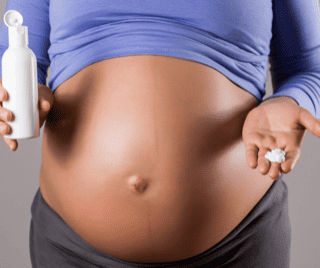Sun Exposure in Pregnancy; Maternal and Fetal Health and Heat Protection Strategies
By Hannah Tizard
Education and organisational development lead midwife, All4Maternity.
Dangers of excessive sun exposure
Exposure to harmful UV rays from the sun is a primary risk factor for sunburn, premature skin ageing, skin damage, and skin cancer. Over 90% of skin cancers are caused by sun exposure. Using tanning beds and tanning lamps also increases the risk for skin damage and skin cancer (Arutyunyan, Alfonso, Hernandez, Favreau & Fernández, 2017).
Physiological changes in pregnancy affect your sun exposure risk factors
Pregnant women are especially sun sensitive due to a number of physiological changes that occur in the body during pregnancy. The risks are significant from very early gestations right through to time of delivery so all pregnant women should be cautious in the sun.
Increased oestrogen
Changes to maternal oestrogen levels stimulate the production of melanin (which helps us to tan). Pregnancy leaves women vulnerable to developing dark patches around the lips, chin, cheeks, and forehead. This condition is known as Chloasma Gravidarum or Melasma – the ‘mask of pregnancy’ and occurs in about half of all pregnant women. Increased exposure to ultraviolet light from the sun is a significant contributing factor (Revelant, 2015). Most women dislike the appearance of Chloasma but it is important to highlight that this is not an infection, it’s not contagious and it is not due to an allergy. Melasma is not cancerous and will not change into skin cancer.
Body temperature
During pregnancy a woman’s body temperature is naturally higher due to heat generated by the increasing metabolic rate which in turn supports the baby (Marshall & Raynor, 2014). Warm weather and sun exposure may raise body temperature further and cause women to feel uncomfortable and predispose dehydration and fatigue.
Changes to the immune system and infections
Pregnancy causes changes to the immune system in general making pregnant women more susceptible to infections. In addition dehydration caused by excessive sunbathing may put pregnant women at risk of kidney and urinary tract infections due to the increased levels of progesterone which decreases the muscle tone of the ureters, causing them to dilate and slow the flow of urine (Marshall & Raynor, 2014).
Dangers of sun exposure in pregnancy

Sunburn
By impacting the body’s ability to regulate its temperature, a sunburn can cause women to have a higher risk for heat-related health problems such as heatstroke. In certain instances, temperature increases can lead to birth defects, especially if they occur before the embryo implants (Strand, Barnett & Tong, 2011). Usually, this is more commonly associated with high fevers; however, a severe sunburn could cause similar effects.
Cramps and dehydration
Excessive sunbathing can drain the body of much-needed fluids, which causes dehydration and overheating (Bucher, 2017). In pregnancy, lack of adequate fluids can cause undue stress and possibly lead to excessive uterine activity or preterm contractions and increase the possibility of premature spontaneous rupture of membranes (waters breaking) (Strand, Barnett & Tong, 2011).
Sun and heatstroke
By causing fluid loss, sunburns can promote dehydration. A pregnant woman can lose over two litres of fluid when exposed to temperatures over 30 degrees C for only ten minutes or longer periods in lesser heat (Bucher, 2017). By increasing body temperature, dehydration can promote the risk preterm labour or miscarriage due to an increase in uterine contractions. Fluid loss can also increase the risk of fainting, dizziness and light-headedness, which can result in dangerous falls. Dangerous scenarios causing confusion and vomiting can be life threatenng and medical help should be sought (Swierzewski, 2015).
Protective factors
Women should be advised that their best defense against these issues is a sunscreen, sunscreens that say “broad-spectrum UVA/UVB,” with an SPF of at least 50 are recommended. Sunscreens that contain titanium dioxide or zinc oxide are deemed safe during pregnancy (Gonzalez, 2017).
Other basic protective factors include recommending pregnant women to sit under an umbrella or in the shade when outdoors for long periods. Women should try to avoid the sun between 12 pm and 4pm as the suns rays are strongest during these times.
Despite skin sensitivities increasing during pregnancy, it doesn’t mean pregnant women have to avoid the sun completely, information and recommendations in this article are not proposed to scare women. A good SPF regime alongside adequate hydration and protective shade will protect both mum and baby.
References
Arutyunyan, S., Alfonso, S., Hernandez, N., Favreau, T., & Fernández, M. (2017). Predictors of Sunburn Risk Among Florida Residents. The Journal Of The American Osteopathic Association, 117(3), 150. doi: 10.7556/jaoa.2017.029
Bucher, J. (2017). Heat Side Effects During Pregnancy. Retrieved from https://www.livestrong.com/article/145996-heat-side-effects-during-pregnancy/
Edwards, M. (2006). Review: Hyperthermia and fever during pregnancy. Birth Defects Research Part A: Clinical And Molecular Teratology, 76(7), 507-516. doi: 10.1002/bdra.20277
Flocks, J., Vi Thien Mac, V., Runkle, J., Tovar-Aguilar, J., Economos, J., & McCauley, L. (2013). Female Farmworkers’ Perceptions of Heat-Related Illness and Pregnancy Health. Journal Of Agromedicine, 18(4), 350-358. doi: 10.1080/1059924x.2013.826607
Gonzalez, I. (2017). The Sneaky Skin Problem You Forget About During Pregnancy. Retrieved from https://www.romper.com/p/do-you-sunburn-more-easily-when-youre-pregnant-heres-the-deal-73797
Marshall, J., & Raynor, M. (2014). Myles textbook for midwives. Edinburgh: Saunders/Elsevier.
Revelant, J. (2015). Melasma: How to cope with skin discoloration during pregnancy. Retrieved from http://www.foxnews.com/health/2015/03/01/melasma-how-to-cope-with-skin-discoloration-during-pregnancy.html
Strand, L., Barnett, A., & Tong, S. (2011). Maternal Exposure to Ambient Temperature and the Risks of Preterm Birth and Stillbirth in Brisbane, Australia. American Journal Of Epidemiology, 175(2), 99-107. doi: 10.1093/aje/kwr404
Swierzewski, S. (2015). Harmful Effects of the Sun, Sun Damage – Sun Safety – HealthCommunities.com. Retrieved from http://www.healthcommunities.com/sun-safety/harmful-effects-of-the-sun.shtml








